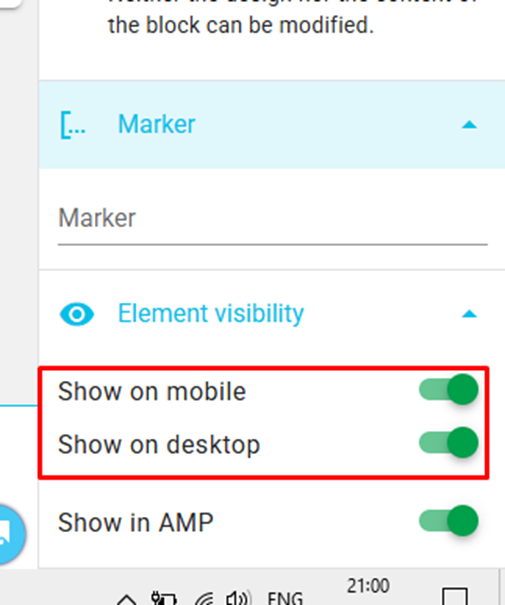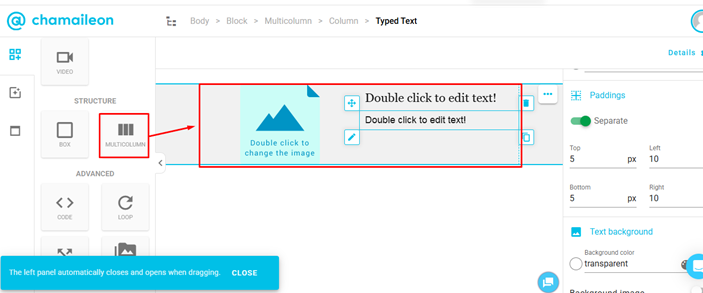The phrase ‘drag-and-drop’ has been overused to the point that many so-called drag-and-drop builders offer no such thing.
At best, you get average drag-and-drop functionality, if that.
“Drag-and-drop became a synonym of an easy to use interface,” says Roland Pokornyik. “Numerous tools, including email editors, are marketed as drag and drop, but that doesn’t always mean that you will get a sophisticated drag-and-drop capability,” he adds.
Pokornyik is the CEO and co-founder of Chamaileon, a truly responsive email builder where you can create responsive emails. The tool offers high-quality templates, client compatibility, and is easy to use; you also get to use Chamaileon’s advanced integration features.
While it is a sophisticated drag-and-drop responsive email builder, our team discovered that the tool tends to override custom CSS. Not a deal-breaker—unless you want custom-coded templates that will reflect your slightly off-centre brand identity or brand aesthetics.
Or when you want to explore gamification in a one-off campaign.
Or even when seasonality forces you to rethink your ideas about inbox experience; custom-coding is key to steer such pivots ably.
Let’s consider the challenge we’re faced with, and find out whether there are viable alternatives to it. Our SME has got the lowdown.
1. The Problem: Custom CSS Overriden
Custom HTML with responsive design does not work properly in the Chamaileon app because the platform automatically overrides custom CSS styling, leading to unexpected layout changes and inconsistencies in the final mobile email design.

But, custom CSS can also get overridden due to one or more of these reasons:
- Since inline styles take precedence over external styles, externally applied CSS will be overridden by certain email clients.
- Email clients have their own default styles, so your custom CSS can get overridden if it’s not supported by some clients.
- One way to get around default styles is to include the !important declaration; however, if default styles also use the same declaration, it risks being overused, leading to maintenance issues.
- Not all email clients support media queries; so if your custom CSS relies on them, expect them to be ignored by certain clients.
Many email builders proactively limit customization efforts to prevent potential rendering issues, rather than addressing them after sending. This approach is reasonable, as email clients can sometimes mis-behave in real-time, contradicting previews and pre-send testing. However, the question is, What do you do about it?
Related: Easeful or Useful: What’s Your Custom Email Template Builder Like?
2. Drag-n-drop: The Better Alternative
So then, instead of using a responsive template with custom CSS, we recommend leveraging Chamaileon’s drag-and-drop functionality. With the inbuilt editor, you can create your template while ensuring that responsiveness is handled automatically. While you may not have full control over the design, you do gain some level of customization.
Chamaileon’s inbuilt editor also provides an option to hide specific blocks or content on mobile and desktop, allowing us to create separate sections tailored for each device.

When using the inbuilt editor to code a two-column section, the layout automatically stacks the columns on top of each other in mobile view, eliminating the need for manual adjustments.
Furthermore, the inbuilt editor supports multi-column layouts, where we can hide specific columns as needed to optimize responsiveness.

So these options allow you to maintain some level of control over your template’s responsive behavior.
Related: No-code vs Hand-coded Email Templates – Which Is Right for You?
3. The “Better-than-Better” Alternative
No, it isn’t going to be a responsive email design tutorial.
And it isn’t about choosing code over no-code, either.
Practically speaking, an email builder, like Chamaileon for that matter, remains essential throughout your email marketing journey. While custom coding may be preferable for one-off campaigns or extensive brand-building, it’s not a matter of choosing one over the other—it’s about adapting seamlessly to your project’s needs at any given time.
However, partnering with a developer skilled in major ESPs allows you to leverage the best of both approaches. Coding and coding for emails are two separate beasts. Therefore, unless you are/have an ace developer or team at your disposal, you’re in for bad inbox experiences.
But how to create responsive email templates beyond the limited sphere of builders?
A full-fledged agency like Email Mavlers can help you. Here’s why:
- Each email template is crafted with precision and includes clear comments, making customization effortless.
- We ensure seamless performance across major email clients, with built-in fallbacks for those with limited support.
- Our templates adapt flawlessly to desktops, tablets, and mobile devices, delivering a consistent experience across all browsers.
- Designed for flexibility, every template is tailored to your chosen marketing platform, ensuring easy edits and reusability.
Let’s get on a call and discuss your specific email template design needs!




